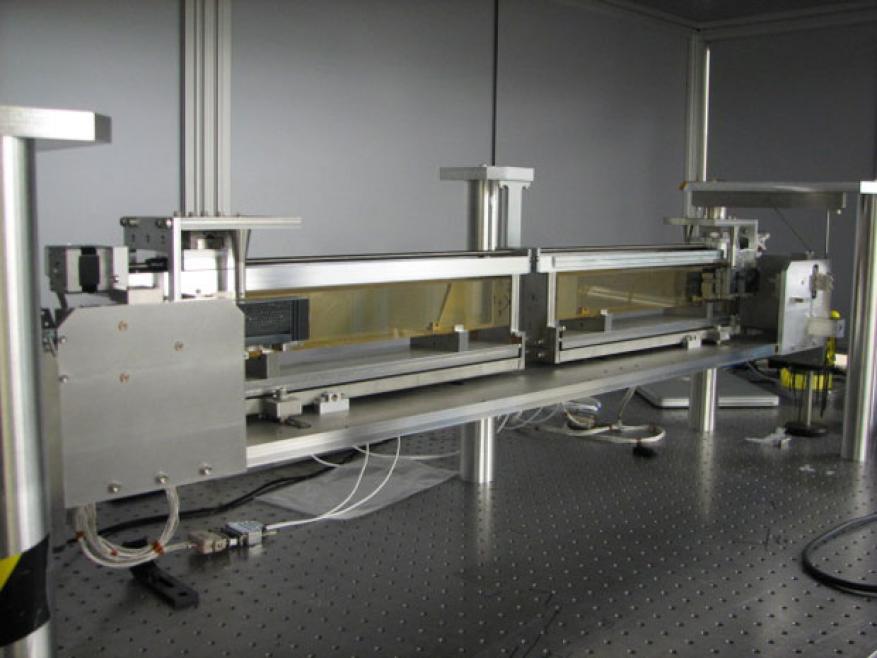Tommaso Pardini (15-LW-002)
Project Description
Use of x rays is an ideal way to characterize ultrafast processes in condensed matter systems because of their sensitivity to both the atomic and electronic structure of the material under study. Experimentally, such ultrafast dynamics are induced by an external perturbation in a process generally referred to as pumping. In today's experiments, pumping is achieved by illuminating the sample with short-pulsed lasers at optical wavelengths. This technique has several drawbacks, including complicated absorption processes and vastly different penetration depths compared to the probing x rays. Ideally, both pumping and probing should be done at x-ray wavelengths. However, the technology to create two x-ray pulses with sufficient intensity and tunable delay time is still lacking. We plan to design, fabricate, optimize, and experimentally validate a multilayer, mirror-based delay line for x rays (MEL-X) to allow, for the first time, high-intensity all-x-ray pump-and-probe experiments to be conducted at a free-electron laser facility. We will demonstrate this capability to study solid-to-liquid transitions in aluminum and silicon, leveraging our team's extensive experience in the field of x-ray optics and multilayer engineering for free-electron lasers and synchrotrons. We will demonstrate functionality of our proposed capability at a free-electron laser facility such as the Linac Coherent Light Source at the SLAC National Accelerator Laboratory in Menlo Park, California, where a substantial number of experiments require pump and probe.
Successful completion of our experimental campaign to validate a multilayer delay line for x rays at a free-electron laser beam line will shed light on the role of core electrons in the ultrafast melting of metals and semiconductors. We expect to split the high-intensity, ultrashort x-ray pulses from the Linac Coherent Light Source into a pump-and-probe beam, using the multilayer delay line. The delay between the two x-ray beams in the system will be obtained by adjusting the position of specific grazing-incidence mirrors, effectively altering the path difference between the two beams. The pump beam will isochorically heat nanometer-scale crystalline aluminum and silicon, initiating the melting process. With the probe beam, we will monitor the melting dynamics by recording on a charge-coupled device the intensity of multiple Bragg reflections as a function of delay time between pump and probe. The demonstration of a multilayer delay line for x-ray technology will benefit the scientific community by simplifying the experimental pump-and-probe setup and eliminating the need for complicated optical–laser integration schemes. In addition, it will facilitate understanding of experimental data given the well-understood processes governing x-ray interactions with matter. Finally, the development of our MEL-X and its application to the study of ultrafast melting in metals and semiconductors will fill a gap in the understanding of fast melting in materials, and its dependence on a particular electronic structure, which will advance our basic knowledge of ultrafast transitions.
Mission Relevance
A multilayer delay line for x-ray technology will benefit experiments in ultrafast transitions to warm dense matter, which are relevant to material behavior under extreme conditions, the understanding of planetary formation and composition, and high-energy-density science in general. This research, therefore, aligns well with the Laboratory's core competencies in advanced materials and manufacturing and high-energy-density science.
FY16 Accomplishments and Results
In FY16 we (1) completed the MEL-X design and drawings; (2) experimentally demonstrated the concept design via a prototype (see figure), which led to a record of invention in October 2015; (3) developed iridium coatings that will provide nearly flat response up to 8-keV photons while withstanding the large x-ray laser fluence generated at the Linac Coherent Light Source; and (4) were awarded beam time at the Linac Coherent Light Source, validating the technical strength of our team's work. The proposal review panel recognized the importance of deploying the MEL-X, suggesting "it might itself enable groundbreaking experiments to be done at the LCLS."
Publications and Presentations
- Pardini, T., et al., "The MEL-X project at the Lawrence Livermore National Laboratory: A mirror-based delay line for x-rays." Proc. SPIE 9589, 95890T-1 (2015). LLNL-PROC-676557.






